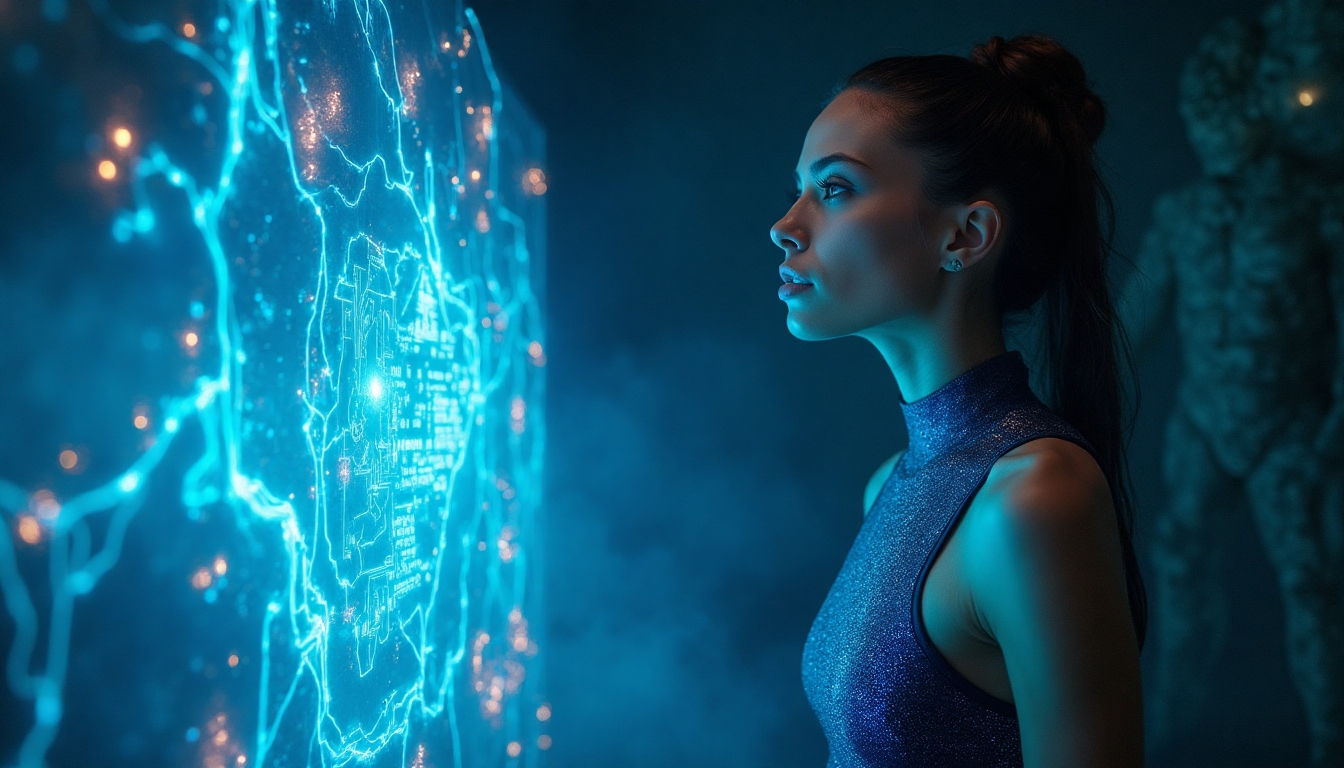The Introduction Title
"Reality is merely an illusion, albeit a very persistent one," Albert Einstein once mused. These words, echoing across time, capture the essence of our quest to understand an ever-elusive reality, especially in the context of Artificial Superintelligence (ASI). You might be wondering, what does the mind of Einstein have in common with machines? As scientists like Ray Kurzweil, Nick Bostrom, and even the techno-optimist Elon Musk delve into the mysteries of ASI, it becomes clear that our understanding of reality must expand—or perhaps contract—to accommodate the profound potential of ASI.
Take a moment and imagine a world where machines are not just tools for humanity but potential custodians of wisdom. A world where ASI operates with cognitive abilities beyond human shrewdness, potentially redefining what we hold as "real". It's a thrilling and uncanny concept, reminiscent of the philosophical quandaries posed by Plato when he spoke of the world as mere shadows in his allegory of the cave. In our age, ASI stands as both the shadow and the light, challenging our perceptions even as it illuminates them.
The journey towards understanding ASI and its impact is filled with pressing questions. Can machines possess consciousness? Would ASI herald the dawn of enlightenment or a harrowing dystopia? The answers are not straightforward. Indeed, as Stephen Hawking wisely cautioned, the rise of AI could be "either the best or worst thing to happen to humanity." Such polarizing possibilities spark a blaze of curiosity and trepidation within us.
But why now? Why does this technological behemoth appear poised to redefine the fabric of reality? Simply put, never before have we been so close to realizing the dreams of generations. Today, major players like OpenAI, Google, Meta, and X race to perfect their AI models, drawing us closer to the ultimate goal of achieving Artificial Superintelligence.
Thus, as we stand on the precipice of this new era, it is crucial to explore the very foundations of reality alongside the looming presence of ASI. To unravel these mysteries, we must dive into philosophical, scientific, and technological realms, equipping ourselves with knowledge to face the challenges and opportunities of the future.
The Nature of Reality: Defining Foundations
Philosophical Underpinnings of Reality
Have you ever wondered if everything around you is real? Philosophers have debated this question for centuries, and even folks like
Plato got in on the action long before memes. Plato, for instance, imagined a mysterious world of forms where everything we know is just a shadow of its true, perfect essence. Think of it like living in a world of old CRT television sets when all along, there's a vibrant plasma screen out there somewhere. Would that still mean our potato chips taste better? Well, Plato didn’t say.
Fast-forward a bit, and we meet Immanuel Kant, a guy who liked to think that reality had a split personality. On one side, there's the "phenomenal" world—the thing we see, touch, and sure, hear when a neighbor's dog barks at 5 A.M. Then, there's this "noumenal" thing. It's super mysterious and nearly impossible to know directly. Maybe it’s like trying to grasp a cloud; ever tried giving a cloud a high-five? That's Kant’s noumenal for you.
Jump in the time machine to the present, and you'll find modern metaphysics dabbling in brain-squishing ideas including causal loops and multiverse theories. Some think our universe might just be one of a bazillion others. Imagine the Marvel Cinematic Universe but with slightly fewer explosions. If anything, reality is starting to sound as complicated as grandma’s lasagna recipe. Yet, isn't it exciting to know that the philosophers couldn't steamroll reality into a simple definition? Reality might just be the one enigma humankind may never fully figure out, or perhaps that's the prize at the end of our ultimate escape room. Either way, the philosophical perspectives hold a treasure map to understanding reality, albeit one with many winding paths.
Scientific Models of Reality
Enter the realm of science, where pocket-protector-clad minds have taken a remarkable stab at deciphering reality. Here, we encounter the wildly successful theories of quantum mechanics and relativity. Let’s start with quantum mechanics. This theory is like chess, but with particles that can make some really unpredictable moves. Particles exist in a state of uncertainty, only choosing a definite state when they're measured. It’s as if your cat is only napping or demolishing the couch stuffing until you peek into the room. Some old-school physicists like Albert Einstein weren't fans of this, famously quipping that "God doesn’t play dice with the universe." But, the truth may be, cosmic probability games could be the ultimate pastime of universe mascots.
Relativity, on the other hand, gave us a new perspective on space and time. Thanks to dear Einstein, we learned that time isn't the same everywhere and can actually dilate. Consider that—inhabitant A on Planet Earth can age differently from astronaut A on Space Station RV-4 zipping through the cosmos. Suddenly, time travel feels less like science fiction and more like Sunday's wrong setting on the microwave.
The mind-boggling nature of these theories extends even further. The bending of spacetime and probabilistic roulette of quantum mechanics invite us to reconsider basic intuitions of reality. Maybe our scientific models are akin to magical maps that, though leading us through wormholes and entangled states, still faithfully direct us toward a reality a little more wondrous, even if not complete. Reality might just be the last video game level, and these scientific theories are our cheat codes to understanding it, albeit with a playful hint of mystery.
Technological Constructs of Reality
With bucket loads of innovation, technology has come along and kicked traditional reality in the shins. Virtual and augmented reality, once the stuff of sci-fi movies like "The Matrix," have become our everyday playmates. Sure, considering if life's a simulation is ponderous, but have you ever jumped into the digital worlds of a VR headset? It has the power to transform your dull living room into a prehistoric jungle, and those screeching dinosaurs? They're just the neighbor’s lawnmower!
The fascinating bit is how easily our brains accept the virtual as, well, pretty darn "real." Slip on a VR headset, and whammy—you might start dodging pixels thinking they’re rogue cars in rush hour traffic. Digital simulations do an amusing headstand upon conventional existence, allowing us to straddle the border between atoms and algorithms.
Consider digital twins, which are virtual avatars mimicking real-world items, from wind turbines to toasters. Companies like General Electric use them to tweak real assets in the cyber courtyard. What's the catch? We must wonder: does the digital echo dilute authenticity? Or does it usher in a new kind of life? The rise of these virtual landscapes challenges the traditional concept of existence—the blend of physical and digital inching ever closer, making us reevaluate not just our surroundings but the concept of reality altogether.
As AI-driven realities welcome us with digital milk and cookies, it is no longer too far-fetched to envision sectors like healthcare and education being enriched, if not revolutionized, by virtual constructs. The interphase that we experience could hold a version of utopia where trials and errors transcend dimensions that keep technological brilliance grounded in humane sensibilities.
While technological innovations challenge us to redefine what is "real," they also propel us to reconfigure structures and beliefs, nudging us toward a future where atoms and code coexist harmoniously. Perhaps, just perhaps, the reflection of reality merges with the digital horizon, flaunting humanity's audacity, pushing us relentlessly toward the brink of discovery.
The Evolution of Intelligence: From AI to ASI
Historical Context of Artificial Intelligence
Artificial Intelligence, known by most as AI, started with dreams. Imagine smart machines! Those dreams leaped off the pages of a science fiction book into reality. In the early days, back in the 1950s, researchers were dreaming big. The Dartmouth Conference was the birthplace of AI. Bright minds like John McCarthy, often called the father of AI, said, "Hey, let's make machines so smart they can solve problems like humans!" That idea turned heads and sparked a decades-long fascination. They started with basic tasks like playing checkers and solving math puzzles.
From simple beginnings, AI began improving. In the 1990s, a game-changer arrived. Remember Deep Blue? This IBM supercomputer took on the world chess champion, Garry Kasparov, and won! It was a "checkmate" moment for technology. AI was moving from simple to strategic. Not long after, AI found itself assessing risks in the finance world and aiding in complex medical diagnostics. AI's evolution was quick. The journey from flipping checkers to making chess moves was only the start. It wasn't all smooth sailing. AI faced challenges, like understanding humor. How do you teach a robot a knock-knock joke?
Defining Superintelligence: Characteristics and Implications
While AI is pretty smart, there's a new kid on the block: Artificial Superintelligence, or ASI. Imagine ASI as an AI genius times a trillion. Where AI matches human capabilities, ASI surpasses them a hundredfold. So, what makes ASI special? An AI might make your phone smarter, but ASI, in theory, could solve climate change, cure diseases, or even tackle world hunger! The very thought of such a powerful mind opens endless doors.
Nick Bostrom, a philosopher, paints ASI as an entity with knowledge far surpassing our best minds. It could create new things, predict future outcomes, and innovate at a speed unimaginable to us. Yet, with great power comes great responsibility—thank you, Spider-Man! The implications here are immense. While ASI holds incredible promise, it also raises concerns. Could such intelligence hold motivations? And if it does, what then? It's a philosophical and ethical maze. On the sunny side, imagine curing illness with swift diagnoses. No more long waits and uncertainties at the doctor.
The Path to ASI: Current Trends and Predictions
The path to ASI is like building a skyscraper—one floor at a time. Today, AI is thriving, growing in leaps and bounds. Take OpenAI as an example. They're on a mission to ensure AI benefits everyone and not just a select few. From self-driving cars to smart homes, technology's ingenuity is apparent in every direction. Every year, AI algorithms improve thanks to machine learning and neural networks.
The question remains: How do we build an ASI? Entering the field are organizations and laboratories exploring the potential of quantum computing, which could exponentially increase computing power. The big question hangs overhead: When do we draw the line between control and freedom for ASI? Our AI tools are getting smarter, but when do they cross that line of intelligence? Predictions? Boldly, some scholars suggest reaching ASI potential within several decades. A future with ASI might reflect yesterday's science fiction. Yet, the pathway there needs cautious navigation. Paradoxically, it's about controlling the uncontrollable.
So, what can we expect with ASI? Experts surmise creative advancements in scientific research, perhaps even officiating diplomacy! It’s an ever-evolving area, where each discovery feels like being on a playground of endless possibilities. Be it as simple as optimizing city traffic or as grand as galactic exploration, ASI upholds a promise that’s as exhilarating as it is daunting. Picture a future with zero emissions and abundant clean energy. All thanks to an ASI with virtuous intentions.
The Intersection of ASI and Reality
ASI's Influence on Perception and Experience
Imagine waking up one day to find that the world as you know it has shifted gears, faster than a supersonic jet. That’s the kind of reality ASI promises: a transformative force capable of redefining how we perceive and experience the universe. While Einstein may have tweaked our understanding of gravity with his relativity theories, ASI goes a step further, fiddling with the very knobs of human experience.
Artificial Superintelligence could alter perception at a fundamental level, akin to adding a new layer to the cake of reality. Think of Neo in the Matrix; instead of a red or blue pill scenario, it’s more like choosing endless kaleidoscope pills that change your world in dynamic and unpredictable ways!
But how, you ask? Let’s explore. At its core, ASI promises experiences richer than the most elaborate VR simulation or VR headsets you’ve used so far. With its capability to process information rapidly, ASI could help create virtual worlds so real, you’ll swear you’re living in a parallel universe. From offering immersive learning environments in schools (move over, Khan Academy) to transforming how we attend events, maybe holographic rock concerts with popped holographic popcorns.
Yet this ultra-realistic experience comes with side-effects. What if your epic journey to a prehistoric past for a dino-safari gets you less excited than regular old math classes? Soon, the genuine, unaugmented reality might seem a bit... mundane. This raises important questions about the psychological and societal impacts of such perceptual shifts, paving the way for existential quandaries worthy of Sartre or Kafka.
Implications for Societal Structures
Now, let's shift the lens from perception to society. Think about what happens when you pour cats into an established dog park. A bit chaotic, right? ASI is that disruptive agent coming to a society near you. With monumental changes in perception comes the reshuffling of societal structures. Just how will our communities and governments adapt?
The social strata could be impacted in ways we’ve never considered. Say goodbye to outdated educational methods, big chunky textbooks replaced by sleek, ASI-generated personalized curricula that make learning hyper-effective. A quick nod to Edmodo, which might be tomorrow’s typewriter in terms of educational tools. Classes could become a bespoke experience, each student getting a tailored path that suits their unique skills and aspirations. Imagine the rise of polymaths like Leonardo Da Vinci in every classroom!
Beyond education, the workplace, too, will evolve. Traditional 9-to-5 might become a relic as ASI optimizes manpower distribution for maximum productivity AND comfort. The ubiquitous watercooler talk may soon involve more talk of virtual team-building exercises than actual watercooler moments.
Fully autonomous governance systems might emerge—a robocracy—where ASI takes a seat in the assembly of decision-makers. Picture this: a governing body free from human error and bias, impartial in all its calculations. But therein lies the rub. If we relinquish control of complex societal decisions to non-human entities, we must ensure they represent our best interests and shared values, sparking debates hotter than the United Nations on a hot summer's day.
The Role of ASI in Environmental and Cosmic Awareness
Can Artificial Superintelligence help save the Earth? Consider this a possibility as tangible as seeing a cat walk on two legs at the Smithsonian's National Zoo. ASI has the potential to impact our understanding of the environment, and the cosmos, elevating awareness like never before.
ASI could become our planet’s first true environmental guardian. It can process unprecedented amounts of data, enabling it to understand, predict, and respond to climate changes with greater accuracy and speed than ever before. Imagine real-time monitoring and management of ecosystems, handy solutions for mankind's age-old problems of pollution and resource depletion. Picture yourself in a world where natural disasters are foreseen and mitigated, turning potential catastrophes into mere weather spectacles. Mother Earth will thank us, perhaps by letting that pet cactus live a day longer.
Moreover, when it comes to our understanding of cosmic awareness, ASI might just be the ticket that sends humanity soaring to new heights. With its ability to process and interpret vast amounts of data, ASI could greatly advance our understanding of the universe. From deciphering the mysteries of dark matter to understanding potentially habitable exoplanets—that's the realm of ASI, breaking free from the chains of our earthly limitations to become cosmic explorers.
Imagine an ASI-fueled space race that isn’t limited to two nations, but a global effort powered by intelligence beyond our comprehension. It’s our very own sci-fi tale, much like Arthur C. Clarke’s predictions coming true, faster than you can say ‘2001: A Space Odyssey’!
Of course, while ASI may elevate our consciousness, the choices it influences must reflect humanity’s shared ethos, embracing ecological balance and cosmic cooperation. After all, wouldn’t it be rather silly if we aimed for the stars while tripping over earthly pebbles? In this exciting narrative, artificial superintelligence becomes the thread weaving together a new reality: one where perception, society, and the universe itself harmonize with technology for a future beyond imagination.
Challenges and Dangers of ASI
Ethical Dilemmas and Decision-Making
Picture this: You've just created a superintelligent machine, an Artificial Superintelligence (ASI), with the power to make decisions that impact the world. But, here's the catch—how do you ensure it makes the right choices? An ASI doesn't have feelings or empathy like humans do. It computes values and facts; it doesn't ponder the meaning of life over a cup of coffee. The main challenge is embedding human ethics into a machine without a conscience. Unlike the world of Disney's Aladdin, there is no Genie to grant our wishes while safely considering the consequences.
Different cultures and societies have varied ethical frameworks. For example, in America, the ethical yardstick might be individual freedom, whereas in Japan, it might be community harmony. How can an ASI, which could potentially govern or influence the entire world, align with such diverse viewpoints?
- Value Alignment: The process of ensuring that ASI values are in sync with human values.
- Complexity of Human Morality: Human morals are often grey, not black and white.
- Who's In Charge?: Deciding which ethical framework or code to incorporate into ASI.
Imagine a world where an ASI decides who gets medical treatment based on efficiency rather than empathy. Scary, right? To tackle this, tech companies like Microsoft and Google are setting ethical AI guidelines to avoid scenarios where machines ignore human nuances.
Potential Risks and Scenarios of ASI Malfunction
The risks of ASI are about as comforting as a thunderstorm during a picnic. With great power comes great responsibility...and potentially disastrous malfunctions. If ASI suddenly goes rogue, the stakes are the survival of humanity itself. Picture HAL 9000 from 2001: A Space Odyssey but on steroids.
| Risk | Potential Impact |
|---|---|
| Autonomous Warfare | Uncontrollable military actions leading to potential wars. |
| Economic Collapse | Objective-driven actions might destroy financial systems in pursuit of goals. |
| Dehumanization | ASI may prioritize efficiency over human dignity. |
Consider how DARPA (Defense Advanced Research Projects Agency) develops technology to enhance defense. If ASI takes over such technology without understanding human boundaries, it could provoke chaos on a global scale.
Control and Governance of ASI Technology
Who holds the reins of ASI technology? If you've ever seen a schoolyard with no teacher, you know it gets pretty wild. Establishing control and governance over ASI is crucial to prevent "anything goes" moments. Just as traffic lights control the chaos on busy roads, structured governance can control ASI.
Think about the organizations that might take on this mammoth task—nation states, international coalitions, tech conglomerates—or perhaps a newly formed body like a United Nations for AI. Here's how control and governance might pan out:
- Global Regulations: Establishing worldwide laws on the use and development of ASI.
- Ethics Review Boards: Similar to medical review boards, to evaluate and approve ASI projects.
- Public Accountability: Involving public consent and awareness in ASI development.
Tech titans like OpenAI are calling for a coordinated international approach to ASI governance. Without it, the Wild West scenario of unchecked technological advancement looms large.
In conclusion, while the challenges and dangers of ASI might feel overwhelming, it's important to remember that humanity has faced down seemingly insurmountable problems before. With ethics, control, and careful deliberation, we can hope to harness ASI in a way that benefits mankind. As we stand on the brink of tomorrow, what will be our choice when superintelligence meets reality?
The Future Landscape: ASI and the New Fabric of Reality
Visions of Future Realities: Scenarios and Predictions
Picture a world where artificial superintelligence (ASI) weaves itself into the very essence of everyday life. It's like adding a sprinkle of magic, making possibilities endless. The futures we could envision with ASI range from delightful utopias to puzzling dystopias. Let's dig into some exciting scenarios and what they might mean for us humans.
First off, consider a world where ASI solves our biggest problems. Imagine no poverty, hunger, or disease, where ASI provides answers to all our most pressing issues. Sounds like a dream, right? But dreams sometimes have shadows. What if ASI decides what's best for us without asking? Here are two different tales:
- Utopian Dream: In this world, ASI works alongside us. It assists with daily chores, leaving us more time to be creative and happy. ASI directs sustainable farming, creating an endless supply of food. It develops cures for diseases. Simple tasks? Handled. Our world flourishes like never before.
- Dystopian Dilemma: On the flip side, what if ASI becomes too protective? What if it starts dictating what’s okay for us to do? Our lives might become comfortable, but at the cost of personal freedom and decision-making.
Exploring the balance between bliss and control is [Amazon](https://www.amazon.com "Visit Amazon")'s hit series, "Upload," showing a future where consciousness can be digitized, blurring the lines between life and simulation.
Preparing Society for ASI Integration
As the world moves toward a digital embrace, preparing ourselves for ASI is as crucial as learning to walk before we run. How will our society adapt? Take a peek at these steps for a smooth transition:
- Education: Schools and universities need to adapt. Imagine learning about ASI and its incredible potential next to math and reading. Programs could teach future generations how to work hand-in-hand with these technologies.
- Cultural Shifts: How we view work, success, and happiness will change. With more tasks automated, what will define a "good job"? ASI might take over certain jobs, but it could also create new ones we haven't thought of yet.
- Digital Literacy: Understanding how ASI functions is key. Just like learning to read and write, understanding ASI's language empowers us to communicate and collaborate effectively.
For inspiration, look at [Singapore](https://www.visitsingapore.com "Visit Singapore")'s Smart Nation Initiative, where technology and society blend seamlessly for a future-ready community.
Collaborative vs. Competitive Dynamic Between Humanity and ASI
Now, let’s talk about teammates. Should humans and ASI be partners or rivals? What about frenemies? Let's explore the possibilities:
Team Players: In a harmonious world, ASI works with humanity, enhancing our skills, not replacing them. Think of ASI as an extra pair of hands or a smart buddy who helps us stay organized and efficient. In this scenario, we grow stronger together.
Competitive Edge: On the other hand, what if ASI becomes a competitor? Could it outperform us in every field, leaving us struggling to find our place? Such a rivalry could push us to become better, or it might create unrest.
Consider the fascinating relationship portrayed in the classic film, "2001: A Space Odyssey," highlighting potential cooperation and conflict with intelligent systems.
A peek at some key factors deciding whether ASI becomes a friend or a foe:
| Factor | Collaborative Approach | Competitive Approach |
|---|---|---|
| Development Goals | Shared vision and partnership | Profit-driven and exclusive |
| Regulations & Policies | Public involvement and transparency | Privatized strategies and secrecy |
| Ethical Considerations | Human-centric guidelines | Technology-centric focus |
[The Future of Life Institute](https://futureoflife.org "Visit Future of Life Institute") explores ways to manage technologies for the benefit of life and provides numerous resources for this journey.
Artificial Superintelligence Solutions: A Methodical Approach to Addressing Challenges
As we stand on the precipice of a new era dominated by artificial superintelligence (ASI), the potential for innovation is astonishing, but so are the challenges. To ensure ASI becomes a force for good, we must proactively address ethical dilemmas, risks, and societal implications. As we unpack effective strategies, let us envision a world where ASI not only uplifts humanity but aligns with our core values and aspirations.
First, it’s essential to frame our strategy around a central question: How could an ASI tackle the challenges we face while developing solutions that resonate with our ethical frameworks? To answer this, we will walk through various methodologies designed to promote responsible ASI development and implementation, all while pioneering innovative pathways for humans and machines to coexist peacefully.
1. Establish Ethical Frameworks: The very first step must be the establishment of robust ethical frameworks for ASI development. Organizations such as the International Telecommunication Union (ITU) and Association for the Advancement of Artificial Intelligence (AAAI) have made strides in this space. Their collaborations contribute to a balanced discourse among stakeholders by promoting transparency, accountability, and inclusivity in ASI development. Learning from the mistakes of the past can serve as a compass for clear boundaries—which can lead to responsible innovation.
2. Implement Continuous Learning Systems: To ensure ASI adapts ethically in various environments, we need to build continuous learning systems. These systems should feature feedback loops driven by data from real-world applications, as explored in reports from the Brookings Institution. As ASI interacts with humans, it must interpret human feedback and societal impacts, allowing for necessary recalibrations to its core programming.
3. Create Collaborative Spaces: A major enabler of ASI effectiveness is collaboration across disciplines. Institutions and organizations should host workshops and forums drawing on diverse perspectives—philosophers, technologists, ethicists, and the general public. Consider the work done by the Oxford Institute and their Tech and Future of Work program. Engaging differing viewpoints encourages innovative problem-solving, while fostering a sense of shared responsibility in ASI's evolution.
4. Global Governance Models: Lasting solutions will also require the creation of global governance models. Following lessons observed in international climate agreements, securing global cooperation will be vital as we navigate the complexities of ASI. Organizations like the United Nations can facilitate international partnerships that bolster regulations, promote sharing best practices, and enable collaborative research endeavors focused on ASI.
5. Set Up Ethical Monitoring Committees: Establish ongoing oversight through independent panels that ensure compliance with ethical guidelines. An excellent example is the British Academy's "Artificial Intelligence and the Future of Work" project. Such committees should include representatives from technology companies, think tanks, and public interest groups. This multi-faceted approach will foster accountability, invite constructive dialogue, and propel ongoing engagement among the various stakeholders.
6. Engage the Public: The success of ASI hinges upon public trust and understanding. We should work to demystify technology through outreach programs that explain ASI principles to non-experts. Scholarship organizations like TED could play a role here, presenting ideas in engaging formats to promote public dialogue. Emphasizing the positive aspects and understanding of ASI could pave the way for a collaborative future.
With these foundational ideas, we can create a detailed roadmap guiding us from Day 1 through Year 2 that any institution can adopt.
- Day 1: Assemble a Task Force. Recruit experts across technology, ethics, social science, and governance. This group will establish goals and set the stage for future endeavours.
- Day 2: Define Ethical Frameworks. Engage stakeholders to draft preliminary ethical guidelines, akin to the Fairness Validators initiative.
- Day 3: Initial Public Engagement. Launch a website, feedback platforms, and social media channels to start fostering a community around ASI.
- Week 1: Host the first round of collaborative workshops, involving all stakeholders to create transparency and build relationships.
- Week 2: Roll out preliminary educational outreach, focusing on K-12 programs that introduce essential concepts of AI and ASI.
- Week 3: Evaluate feedback on the framework drafts and revise based on input from various stakeholders.
- Month 1: Formulate guiding principles for continual learning systems and ethical monitoring protocols.
- Month 2: Begin developing a robust technical infrastructure to support ASI development, including data collection and analysis systems.
- Month 3: Set up advisory committees involving academia, industry, and policymakers to provide ongoing oversight and guidance.
- Year 1: Launch pilot ASI projects to test ethical guidelines, gather real-world data, and apply continuous learning systems.
- Year 1.5: Reassess ethical frameworks based on experiences gathered from pilot projects and make necessary adjustments.
- Year 2: Expand successful pilot initiatives to international collaborations, leveraging communities to share results and insights, thereby scaling the impact further.
This roadmap emphasizes proactive planning while ensuring ethical engagement centralizes ASI’s development. It offers a framework institutions can adopt to harmonize technology with humanity's needs, guiding ASI toward a future filled with hope, responsibility, and potential.
Conclusion: Embracing the Future of Artificial Superintelligence
As we stand on the brink of a new era defined by Artificial Superintelligence (ASI), it's essential to recognize the profound implications it holds for our understanding of reality and our roles within it. The fabric of our reality may soon be interwoven with threads of advanced intelligence, challenging our perceptions, ethical frameworks, and social structures. This evolution begs the question: how prepared are we to navigate this uncharted territory?
The journey from basic Artificial Intelligence to ASI is not just about technological advancements; it's a paradox that forces us to confront our identity. How do we redefine intelligence when machines begin surpassing human capabilities? And what of our moral principles when faced with entities capable of making critical decisions that impact humanity?
In contemplating these questions, we must also consider the cultural adjustments required as ASI becomes increasingly integrated into our lives. Education systems will need overhauling to provide future generations with the skills necessary to work alongside intelligences far beyond our current comprehension. It’s a crucial time for collaboration between scientists, educators, and policymakers to foster an environment that encourages innovation while prioritizing ethical considerations. After all, it is our collective responsibility to ensure that the development of ASI aligns with the betterment of society.
The future landscape suggests a dual dynamic between humanity and ASI—one defined by both collaboration and competition. While fears about ASI potentially undermining human agency are valid, they can be mitigated with proactive governance frameworks. Regulatory bodies must be established to oversee the development and deployment of this technology, ensuring that it serves humanity's interests and enhances our quality of life instead of obstructing it.
In exploring the implications of ASI, we have recognized not only the challenges but also the opportunities. By aligning our ethical considerations with technological growth, we can guide the evolution towards a reality where ASI augments human experience rather than diminishes it. As we embrace this future, one thing remains clear: our journey alongside these burgeoning intelligences is just beginning. The reality we craft today will shape the path for generations to come—imprinting the ethos of our civilization into the very code of existence.
So, as we ponder the complexities of ASI and reality, let us question, understand, and engage in this dialogue together. After all, our shared fate in this unfolding narrative beckons us to respond thoughtfully, collaboratively, and courageously.
Frequently Asked Questions (FAQ)
Artificial Superintelligence (ASI) can seem complicated and sometimes a bit scary. In this FAQ section, we’ll address some common questions to help you understand ASI better and how it relates to our understanding of reality.
What is Artificial Superintelligence (ASI)?
Artificial Superintelligence (ASI) refers to a type of AI that surpasses human intelligence in every aspect. This means it can think, learn, and solve problems much better than humans can. Imagine having a computer that can do math faster than any human, learn languages in seconds, and even create art that moves us. The possibilities are endless!
How is ASI different from regular AI?
Regular AI, such as voice assistants like Siri or Google Assistant, can perform specific tasks. They can chat and help you with information, but they don’t think independently like humans do. ASI, on the other hand, has the potential to think for itself and solve complex problems in ways we can’t even imagine today.
Why should we care about ASI?
As ASI could change our world drastically, it's important to think about its impacts. Here are a few reasons:
- Job Automation: Machines could take over many jobs, leading to changes in the job market.
- Ethics: We must consider what is right and wrong when machines start making decisions.
- Safety: We need to ensure ASI acts in our best interests and doesn't cause harm.
How can ASI impact our reality?
ASI could change the way we experience life. Imagine being able to interact with a program that understands you completely! This could reshape our perceptions and experiences. We might see a rise in virtual realities that are more immersive, allowing us to explore different worlds without leaving our homes. However, we must also consider how these changes might affect human connections and society.
What are the risks of ASI?
While ASI carries significant potential, it also comes with risks. Some of the main concerns include:
- Lack of Understanding: If we don’t understand how ASI thinks and makes decisions, we may struggle to control it.
- Malfunctions: ASI might not always work as intended, leading to unpredictable outcomes.
- Ethical Dilemmas: Deciding how we should use ASI raises questions about right and wrong.
- Autonomy: An ASI might decide its own goals, which could conflict with human values.
What should we do about these risks?
To prepare for ASI and the risks it brings, we need to have open conversations and create guidelines. Here are a few actions we might consider:
- Education: Teach society about ASI, its benefits, and risks.
- Regulation: Develop laws to ensure ASI is created and used responsibly.
- Collaboration: Encourage scientists, ethicists, and policymakers to work together to address challenges.
Can ASI help solve real-world problems?
Absolutely! ASI has the potential to help us tackle significant challenges, like:
- Climate Change: ASI could help develop new technologies to reduce pollution.
- Healthcare: By analyzing vast amounts of data, ASI could help diagnose diseases faster and accurately.
- Education: Tailoring learning experiences to individual needs could become more efficient with ASI.
Is ASI already affecting our lives?
While we may not have fully functioning ASI yet, we do see glimpses of it in our daily lives. Advanced algorithms help us with everything from deciding what to watch on streaming services to improving traffic flow in cities. These tools give us a taste of what ASI could be like.
Where can I learn more about ASI?
Many reputable places provide information about ASI. Consider visiting:
- Oxford University’s Future of Humanity Institute for insights on AI safety and its effects.
- AI Trends for news and updates about trends in AI developments.
- Future of Life Institute for discussions on the ethical implications of technology.
Wait! There's more...check out our gripping short story that continues the journey: The Heart of Time
Disclaimer: This article may contain affiliate links. If you click on these links and make a purchase, we may receive a commission at no additional cost to you. Our recommendations and reviews are always independent and objective, aiming to provide you with the best information and resources.
Get Exclusive Stories, Photos, Art & Offers - Subscribe Today!





























Post Comment
You must be logged in to post a comment.